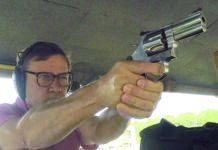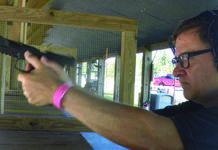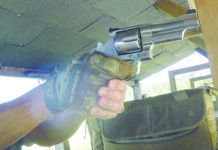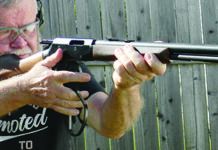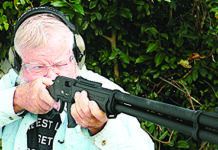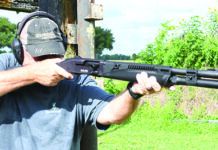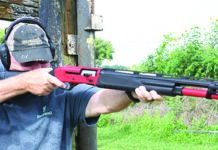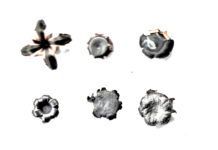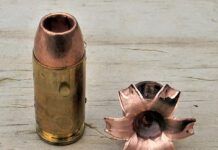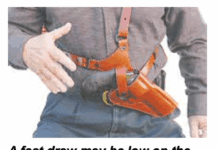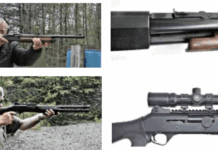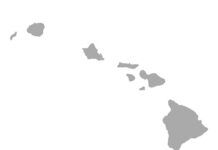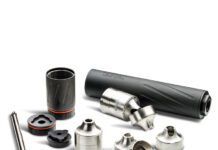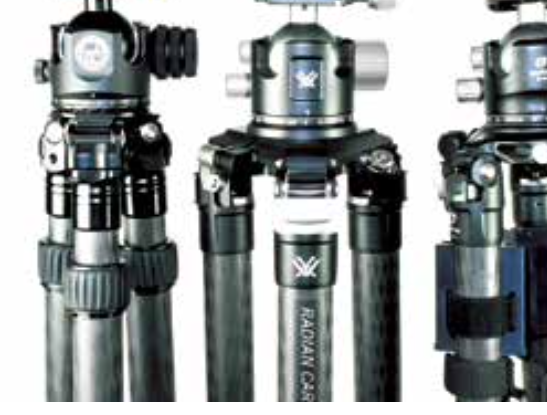It is an accepted fact that the rifle shooter will be able to place his hits more accurately when using some type of supported position. That is, shooting off a bipod from a prone position is going to be infinitely better than standing offhand. As a result, we’ve learned to use bipods, bags, backpacks, shooting sticks, and more in our efforts to achieve stability with our long guns. The latest trend we’re seeing is the use of tripods for support in a variety of field positions and elevations. We see people using tripods made with conventional and inverted legs, Arca Swiss or Picatinny clamps and Hog Saddles, QD and screw-down clamps. Leg dimensions vary, as do the types of ball heads.
The styles are many and varied, and we wanted to see what worked, so we obtained samples of several that were recommended by our local Precision Rifle Series (PRS) Club members and started shooting. Not only did we want to test the unit as a whole, but we also wanted to look at individual features to see what we liked or didn’t like. We looked for speed of deployment, durability, and versatility as well as stability. First, we tried the Boghunt DeathGrip carbon-fiber tripod with the Hog Saddle/Arca Swiss combo mount ($400). We looked to Leofoto for a slightly less expensive option in the LH 55 Model ($227) mounted on the SO-322C tripod ($338). Our third test item was the Vortex Radian Carbon Fiber Tripod ($659). This sample had an excellent QD ball head ($284). Last, we tested a Two Vets Recon V2 LSI (Inverted) tripod ($605) with the 55mm Dual Tension Ball Head and Area 419 Arca Lok QD clamp capable of handling Arca Swiss and Picatinny rail mount hardware ($270).
How We Tested
We didn’t have any Colorado elk hunts coming up that would require us to pack our gear in and our animal out, 143 miles, uphill both ways, in the snow. So, we decided to do the next best thing and try the gear out in competition. Texas Precision Matches (Facebook.com/TXPrecisionMatches/) holds a monthly PRS match that requires many positions and presents targets that range from 400 to 1100 yards. Not all stages are suitable for tripods and, because we really couldn’t evaluate four different units while competing in a single match, we brought the match scenarios back to American Shooting Centers (AmericanShootingCenters.com) and tried to evaluate all four tripods using a common scenario from the match. We shot those groups at 400 yards using a standing supported position from a barricade. The fore end was rested on a Mini Fortune Cookie bag ($85) from Wiebad.com. The tripods were employed as a stabilizing brace for the support hand and the stock. We also tested each tripod at 200 yards by clamping the rifle in the head and shooting a group from there, a scenario we thought would be much more useful for hunters.
Each of our four systems provides a three-legged stand (which is much more stable than two-legged versions), a means of adjusting the legs, and some type of clamp to hold the firearm. Differences exist in type and gauge of materials as well as the mechanisms that are used to hold things up and clamp things down. All of the tripods we selected are built from carbon fiber. We broke down the features we looked for and listed some of the options that are available for each. On each unit, we started with the legs and worked our way up from the rubber foot pads to the axles that control leg-angle adjustments. We included a chart showing which tripods offered which features and graded the tripods on how well we felt the supports did.
We used the match rifle of one of our test members — a Masterpiece Arms BA PMR chambered in 6 Creedmoor, scoped with a Vortex Gen III Razor 6-36×56 and a Spuhr mount. The chassis on the MPA sports an ARCA Swiss rail that runs almost the full length of the fore end. We used a more conventionally stocked Christensen Arms Ridgeline chambered in 6.5 PRC to test the Hog Saddle on the Boghunt. That particular Christensen Arms Ridgeline will deliver consistent 0.6-inch groups, and the MPA will print sub-0.4-inch groups.
Boghunt DeathGrip Infinite Carbon Fiber Tripod,
$400
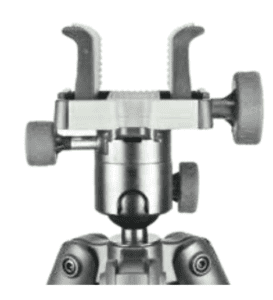
The bottoms of the legs on the Bog DeathGrip Infinite tripod are capped by beveled rubber pads for stability and to keep debris out of the legs. The Bog version caps have a threaded socket that holds a spike. It uses a much more pointed tip that can be unscrewed from the cap, reversed and screwed back in. Were we using the Bog tripod on a soft surface that we didn’t mind poking holes in, we’d install the spikes and gain the extra stability. As is, we were practicing with these on wooden floors, so we stayed with the rubber tips. You can decide which is more appropriate for you knowing that change out was quick and easy.
While some of our samples use inverted leg locks, the Bog DeathGrip uses standard locks. To adjust leg height, the lock is twisted (normally clockwise to unlock, but the Leofoto is counterclockwise) about a quarter turn to release the lock. On the traditional lock, the user would let go of the lock, move the leg up or down as desired, move back to the lock and tighten things down. The system is effective, easy, and pretty quick. Both the Leofoto and the Two Vets tripods use an inverted lock. With that type, first rotate the lock, then while maintaining hold of the lock, adjust the leg and retighten. Either system will work fine, though we admit a slight preference for the inverted style. With the standard mechanism, the legs collapse to the joint when unlocked. That movement leaves the locks at the bottom of the leg, which can place the lock in immediate contact with whatever debris is present. The inverted locks leave the joint at the top of each segment, protecting them, and we think the inverteds are a little bit better. We also feel the inverted system, with fewer movements required by the hands, to be slightly faster. Neither of these is a deal breaker. We made both types work just fine.
Leg length and height varied by brand as well. The Bog DeathGrip uses three leg segments, which means the individual segments did not have to be as long as, say, the Leofoto and the two segments that tripod uses, to provide sufficient lift. More segments also meant it could be collapsed shorter in case storage in your house or in your backpack is at a premium.
The legs attach to the head via an axle. We saw two different systems that allowed the legs to be extended at different angles for use in different terrain or for when the shooter needed the firearm at a different height. The Boghunt uses a push pin that reminded us of a cross-bolt safety on a Marlin lever-action. With the pin all the way to the right, the number “85” shows in a window and the legs can be set up almost parallel to the ground for a prone shot. The middle position shows “45” and was a great angle to use for seated shots. The far-left position brings “20” into the view port and provides almost vertical legs for those taller needs.
The legs and axles meet at a center section, and we saw several different concepts on that, too. The Bog DeathGrip was a fixture from which protrudes a 3⁄4-inch spindle and an integral ball, where the clamp is attached. The primary clamp on the Bog DeathGrip is designed to fit an Arca Swiss rail and tightens with a single thumb screw. The clamp tightens on the rail using a second thumb screw. This Bog Death Grip also shipped with a Hog Saddle that tightens with yet another screw. The Arca Swiss units tighten onto a rail on the fore end. The Hog Saddle clamps down onto the side of the receiver and would be much more applicable to most conventionally stocked hunting rifles.
The clamp on the DeathGrip is not quite as sophisticated as the other three, so we wondered how it would compare. We found that it was a little more likely to work its way loose after repeated shots, but it did well when we kept it tight. For example, we recorded a 3.17-inch group at 200 yards with this system. The first three shots went into a mere 0.954 inches at 200 yards from a standing supported position. The group opened a bit with the last two shots, then we tightened things back down and all worked well again. We really liked the way that the system shipped with both clamps and thought that would be very versatile for hunters. There is a lot of value here for the least expensive tripod in the group.
Our Team Said: The Bog DeathGrip is made in America — as are two of the others — and is relatively inexpensive. As long as we kept the Hog Saddle tightened down, this carbon-fiber tripod did very well. Also, BogHunt has an aluminum version that runs a mere $200.
Gun Test Grade: B
Leofoto SO-322C Tripod ($338) LH 55 Head ($227)

We borrowed this unit from a PRS competitor who has customized it with a couple of things you need to know about. But, first, the details.
As with the other tripods in this test, the Leofoto uses carbon fiber in the legs to keep things as light and strong as possible. However, the legs only have two segments. Because this is the tallest tripod in the group, that means those legs are fairly long, and it also means that the Leofoto does not collapse as short as the others. The SO-322C tripod uses inverted locks, making them easy and quick to handle. Then they had to do the locks opposite of everyone else. You twist away to unlock and toward you to lock. Again, no big deal. Just know your equipment. The feet provide solid rubber pads, but there were no provisions for spikes.
What we are calling axles at the top of the legs — perhaps pivot points — allow the same changes that the Bog DeathGrip does but uses a different mechanism. Instead of a cross-bolt, Leofoto (as well as the Vortex and Two Vets units) use a lock that pushes in instead of sideways. When the legs have been extended to maximum travel, notches impinge on the lock, limiting further movement. Simply pivot the leg in toward the ball head slightly to relieve pressure on the lock, pull out the tab, spread the leg to one of the other two detents, and push the lock back in. The process is simple and sturdy.
The ball head on these last three samples uses a more refined clamp and center section. A circular ring provides attachment points for the legs and an open ring for the ball head. The Leofoto and the Vortex use very slick quick-detach heads that we really liked. Simply loosen the thumb screw, press in the tab, lift out the head, and put in a different attachment, if needed. And different attachments are very common. When we transited the match, we were constantly stepping over tripods that were loaded with shooting bags, cameras, spotting scopes, and binoculars. The ability to pop out one accessory and instantly replace it with another may be a bit expensive, but it is very convenient to use.
The head on the Leofoto (as well as the Vortex and the Two Vets) is secured with dual tension clamps. Two small thumbscrews are co-located on one side of the ball head. This allows the desired amount of drag to be pre-tensioned on the ball. Without this option, if the shooter loosens the larger lock (located on the opposite side), there is nothing to prevent the mounted options from falling completely through whatever arc is available. Not a great situation with a 20-pound rifle or an expensive optic. When we used these tripods at the 200-yard range, we pre-tensioned the clamp, tightened the Arca rail down on the rifle’s chassis, and then loosened the large knob a little, as necessary, to make fine adjustments on the target. The Arca Swiss rail attachment worked great. The thumb screw was easy to manipulate and very secure once tightened.
A PRS shooter carries a lot of gear at a match because you never know what you might need. We’re old enough to pull a cart at the matches because we are supposed to be smart enough to roll things instead of carrying them. Then where do you put all that gear? The tripod can be a very convenient place. Many matches have the Range Officers using iPads. Where do you put that? Leofoto (LeofotoUSA.com) sells something called a Rock Bag to help load a little extra weight and stabilize the tripod. We think it works great for shooter’s gear, too. Will Conlan (search for “ConlanClanPrints” online) has developed a great set of printed “holsters” to help the shooter put a Kestrel or timer where it is easily accessible. The modern hunter will likely also carry a weather meter and a good set of binos. The same accessories also work for them and weigh almost nothing.
We did a very unscientific survey at the PRS match, looking at tripods to see who had what. The Leofoto with its feature set and a moderate price was very popular. We really liked shooting with their tripods and didn’t really feel tons of difference in stability, but the results showed otherwise. Now we’re being picky. The Leofoto had the largest groups of any of the four tripods. All the way up to 1.4 MOA. That’s deer worthy — or match worthy a long way out!
Our Team Said: Very popular with our PRS crowd, this Chinese-made tripod brings excellent features at a better price than the Two Vets or the Vortex. But it wasn’t quite as stable for us.
Gun Test Grade: B+
Vortex Radian Carbon Fiber Tripod ($659) Radian Ball Head ($284)
We learned early on in competitive shooting that we didn’t have time to worry about our gear in a match. Everything needs to work every time. The gun must go bang and hit what we point it at. Go to a PRS or 3-Gun match, look at what gear competitors use, and you might be amazed at how often that gear is made by Vortex. If it breaks, Vortex fixes it. Yes, we have tested them and found that to be true. We have no doubt that would be valid with their tripod as well.
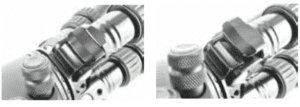
The Vortex Radian arrived in a carrying case well equipped with extras. One pouch held a nice multi-tool including all necessary wrenches. It also contained an Arca Swiss-sized plate with a ¼-inch through bolt that easily allows the Vortex tripod to be used for mounting cameras or spotting scopes. A second pouch included spiked feet for the legs. Just unscrew the attached rubber pads and replace them with the spikes. Since the Vortex system uses four-segment legs, the collapsed unit is short, requiring the carrying case to only be about 31 inches long. It is very easy to store and maneuver.
The Radian reminds us of a slightly more rigid version of the Leofoto and contains many of the features we liked about the other brand. Locks on the leg joint are the standard type and only require about a quarter turn to unlock. Note that with four leg segments the shooter can achieve just about any angle and height desired, but there are a lot of locks to manipulate. The axles at the top of the device use the push pins common also to the Leofoto and the Two Vets models. Relieve the pressure on the pin, pull it out, select one of three different angles ranging from near vertical to almost horizontal, and push the pin back in. The ball head is also a QD type. Loosen the thumb screw, press the button, lift up the head, and the mount is ready for just about any other 55mm ball head. It also uses the two locking screws on one side of the head with the larger tension knob on the other. We confess to using the locking knobs to set tension and then manipulating the larger tension knob to release the lock. Either works. The Arca Swiss clamp on top is tightened with a thumb screw that was easy and fast to use. The bottom side of the ball head provides a hook onto which extra stabilizing weight can be hung, if needed. Both the center section and the Arca Swiss clamp sport bubble levels.
The Vortex Radian combination took second place in the stability battles and didn’t miss first by much. The 400-yard group we shot with it measured a mere 0.76 MOA when shooting standing supported. We can’t think of too many targets we couldn’t hit with that kind of support.
Our Team Said: By the time we get to this level of tripod (and cost), it is almost like comparing a Lexus to an Acura. Both are splendid vehicles. Which has the best ride for you? The Vortex was very stable, very versatile, and very easy to use. Those last two terms don’t always go together. We really liked the Vortex.
Gun Test Grade: A-
Two Vets Recon V2 LSI Tripod ($605) 55mm Dual Tension Ball Head ($270)
A couple of guys up in New York started a company to supply gear to precision shooters a few years back. Ownership has changed a bit, but Daniel is still there and is concentrating on tripods. Two Vets (TwoVetsTripods.com) produce several different types both of tripods and heads. Our sample is the Recon V2 LSI and with a 55mm Dual Tension Ball Head with the Area 419 Arca Swiss lock. How’s that for a mouthful? All that translates down to sturdy legs with inverted locks, foot spikes, and a head that uses a quick-detach lock from Area 419 to secure anything with an Arca Swiss or Pic rail.
The head resembles the Leofoto and the Vortex, with very similar tilt and pan locks along with the drag tension screw. Operation was easy and smooth. We thought locking into the QD clamp was easier than any of the other units we tested. The QD mount even had a lock on the lock. Just slide your rail-equipped anything into the slot and rotate the lever through 90 degrees. A little bit of slop is allowed. That could be a good thing since we didn’t find all Arca Swiss mounts to be exactly the same width. Once the gear is in the slot, the shooter can push a tab on the opposite side of the lock that slides four ball bearings into place and really locks everything down. Also, as with the Leofoto and the Vortex, two areas are machined out of the front of the ball head that will allow a rifle to be tilted almost to the vertical.

The Two Vets ball head also differed from the others in how it attached to the tripod. We like the concept of quick-detach mounts when practical. If they can spend the cash, the shooter can have a sporting scope or binoculars mounted on one head and a camera on another. Change out requires only a few seconds. The Two Vets model mounts onto the 75mm center section using a 3⁄8- or ¼-inch male stud (both are provided). The ball head screws on and is then tightened down by hand. A non-marring Allen screw can be tightened from underneath the center section to lock everything down. We thought it was a bit more cumbersome to change out. Then we looked at the shooting results and decided the system was just fine.
As with all of these samples, the legs on the Two Vets tripod are carbon fiber — strong and light. They use three segments with inverted locks. The surface of the locks is covered with a non-slip surface that grants good purchase. They also serve as a stop as the legs are pushed back together. This keeps the legs from over-rotating and getting jumbled as the unit is collapsed for storage. The other units come with a good carry case, but not the Two Vets. There is a carry strap that is available on the website, but at extra cost.
Shooting tests with the Two Vets system yielded a 0.83-MOA group at 200 yards and a 0.68-MOA group at 400 yards. That was a 2.85-inch group, standing-supported, at 400 yards.
Our Team Said: The Two Vets tripod had a couple of features we really liked in the inverted locks and the Area 419 QD release on the Arca Swiss clamp. Controls were very similar to the Leofoto and the Vortex, but the ball head was not a QD-style release. That made changing out the head slower, but it might have made it more stable.
Gun Test Grade: A-
The Bottom Line
Remember that we started out this process by asking a group of competitive shooters, many of whom also use the same gear to hunt, what their preferences were in regards to using a tripod. We shot several photos from the match showing competitors and their gear. We almost couldn’t see the trees for the tripods. We found many Leofoto units present. Vortex and Two Vets were not there in quite the same force, but we still found them to be very common.
We also confirmed that the lock type may not be quite as critical to competitive shooters as to hunters. Hopefully, the tripod-equipped hunter would have at least a moment to set up his tripod and lock in his rifle. The competitive shooter seldom has the time to lock in anything, especially when multiple positions are required. Most of what we did was use the partially-extended tripod leg as a rear support for our buttstock. The stability possible from that is incredible, if unconventional. We did see shooters everywhere resting binoculars on bags to spot impacts and misses.
All four tripod systems did some great work, but we had favorites, of course.
Our Pick would go to either the Two Vets or Vortex tripods. They had slightly different feature sets, but both performed well and were very stable. Next, we would look at the slightly more price conscious Leofoto. The Best Buy is the Bog DeathGrip. At any price it did well. For the actual price point, it did extremely well.
| TRIPOD SPECIFICATIONS | ||||
|---|---|---|---|---|
| Feature | Leofoto | Vortex | Two Vets | Boghunt |
| Number of Segments | 2 | 4 | 3 | 3 |
| Max Height | 70.5 in. | 67.5 in. | 69.75 in. | 60.5 in. |
| Diameter Segment 1 | 32.6 mm | 36 mm | 30.3 mm | 35.3 mm |
| Diameter Segment 2 | 36 mm | 32.8 mm | 34.6 mm | 32 mm |
| Diameter Segment 3 | NA | 28.2 mm | 38.6 mm | 28.2 mm |
| Diameter Segment 4 | NA | 25.6 mm | NA | NA |
| Leg Material | Carbon Fiber | Carbon Fiber | Carbon Fiber | Carbon Fiber |
| Lock Position | Inverted | Standard | Inverted | Standard |
| Head Diameter | 55mm | 55mm | 55mm | 44mm |
| Head Attachment | QD | QD | 3/8 or 1/4 in. Stud | Center Spindle |
| Dual Tension? | Yes | Yes | Yes | No |
| Clamp Type | Thumb Screw | Thumb Screw | Area 419 QD | Thumb Screw |
| Arca Swiss | Yes | Yes | Yes | Yes |
| Picatinny Rail | No | No | Yes | Yes |
| Hog Saddle | No | No | Available | Yes |
| Other Heads Available? | Yes | Yes | Yes | No |
| Stability Rating (1 - 5) | 4 | 5 | 5 | 3.5 |
| Gross Weight | 6.65 lbs. | 6.95 lbs. | 6.05 lbs. | 6.44 lbs. |
| Foot Styles | Rubber | Smooth/Spike | Smooth/Spike | Smooth/Spike |
| Carrying Case | Yes | Yes | No | Yes |
| 200 Yard Group | 3.02 in. | 2.13 in. | 1.735 in. | 3.17 in. |
| 200 Yard Group | 1.44 MOA | 1.02 MOA | 0.83 MOA | 1.51 MOA |
| 400 Yard Group | 6.01 in. | 3.2 in. | 2.85 in. | 4.82 in. |
| 400 Yard Group | 1.44 MOA | 0.76 MOA | 0.68 MOA | 1.15 MOA |
| Street Price | $565 | $943 | $875 | $400 |
Written and photographed by Joe Woolley, using evaluations from Gun Tests Team members. GT




